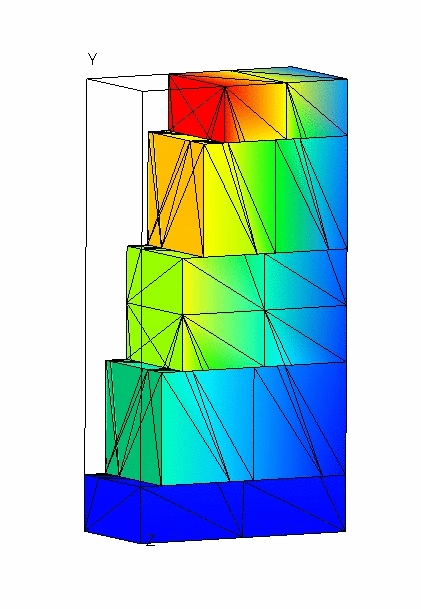5. C modeling#
5.1. Characteristics of modeling#
It is the same modeling as modeling A, but in 3D.
5.2. Characteristics of the mesh#

Figure 5.2-a: The C modeling mesh
The mesh comprises 4 cells of the HEXA8 type, represented in FIG. 5.2-a.
Same remark as for the modeling mesh A. Some meshes « see » 2 cracks, they have the degrees of kinematic freedom DX, DY, DZ, H1X, H1Y, H1Z, H2X and H2Y, H2Z as well as the degrees of freedom of Lagrange LAGS_C and LAG2_C as well as the degrees of freedom of Lagrange and. Others « see » 4 cracks, they also have the kinematic degrees of freedom H3X, H3Y, H3Z, H4X as well as the degrees of freedom of Lagrange and. Others « see » 4 cracks, they also have the kinematic degrees of freedom H3X, H3Y, H3Z, H4X and H4Y, H4Z as well as the Lagrange degrees of freedom LAG3_C and LAG4_C.
5.3. Tested sizes and results#
The quantities tested are identical to those described in modeling A. The stair deformation in FIG. 5.4-a is obtained.
Identification |
Reference |
SOMM_ABSpour DX- \(\text{Depl\_X}\) (master side) |
0 |
SOMM_ABSpour DY- \(\text{Depl\_Y}\) (master side) |
0 |
SOMM_ABSpour DX- \(\text{Depl\_X}\) (slave side) |
0 |
SOMM_ABS for DY- \(\text{Depl\_Y}\) (slave side) |
0 |
Table 5.3-1

Figure 5.4-a: Deformed structure.
We test the value of \({E}^{e}\) produced by the POST_ERREUR operator.
Identification |
Reference type |
Reference value |
Tolerance |
Ee |
“ANALYTIQUE” |
2.6 107 |
|
We test the value of \({\Vert u\Vert }_{{L}^{2}}\) produced by the POST_ERREUR operator.